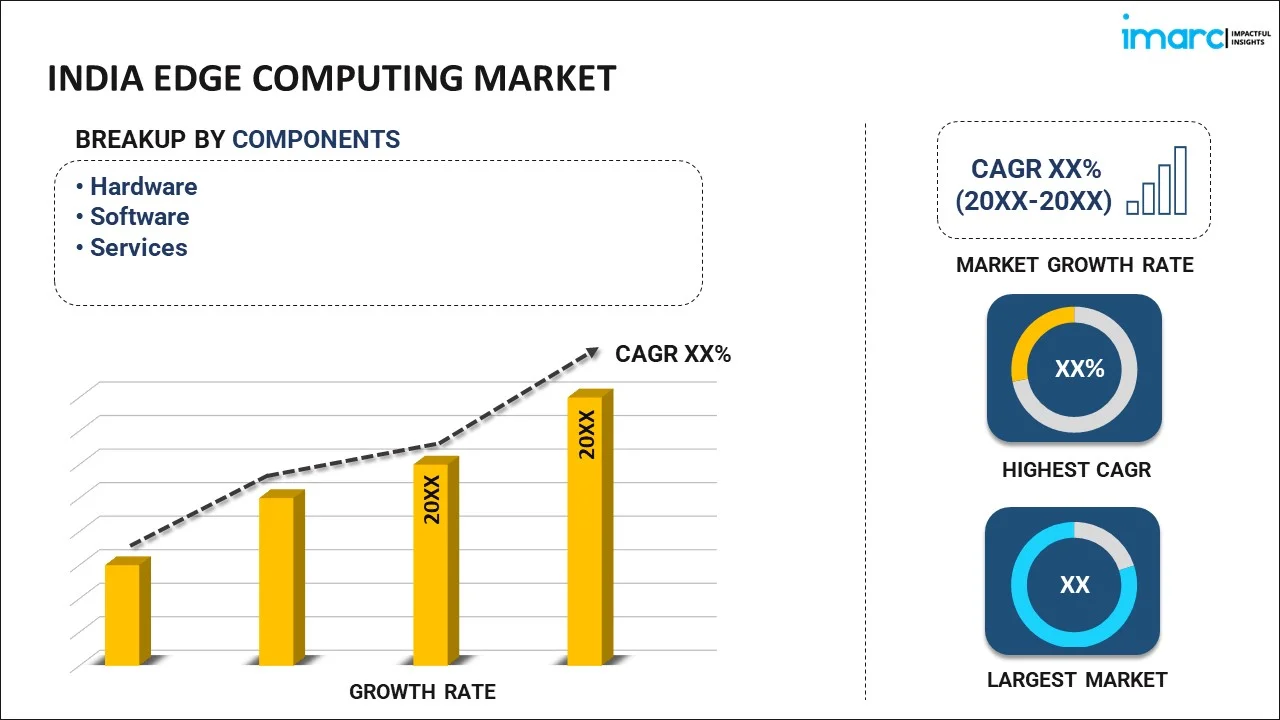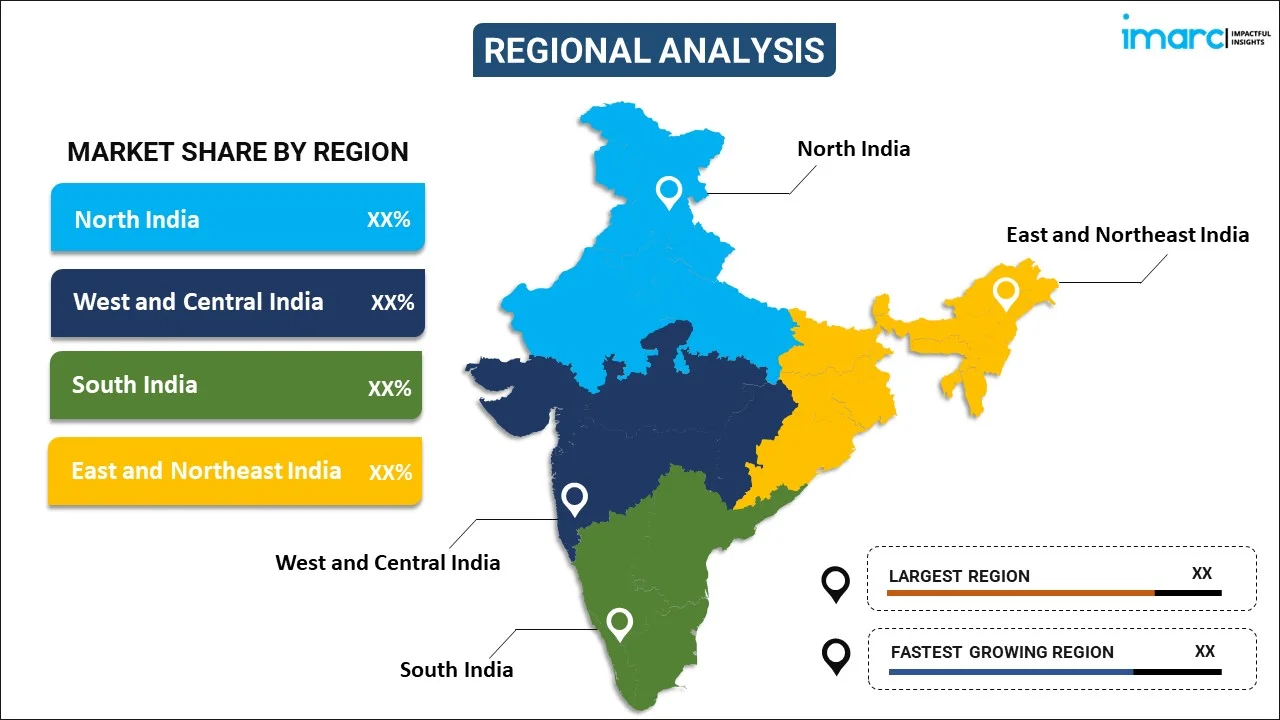
India Edge Computing Market Report by Component (Hardware, Software, Services), Organization Size (Small and Medium-sized Enterprises (SMEs), Large Enterprises), Vertical (Manufacturing, Energy and Utilities, Government and Defense, BFSI, Telecommunications, Media and Entertainment, Retail and Consumer Goods, Transportation and Logistics, Healthcare and Life Sciences, and Others), and Region 2025-2033
Market Overview:
India edge computing market size reached USD 567.3 Million in 2024. Looking forward, IMARC Group expects the market to reach USD 2,366.8 Million by 2033, exhibiting a growth rate (CAGR) of 15.7% during 2025-2033. The increasing number of internet-connected devices with real-time processing capabilities is primarily driving the market growth.
|
Report Attribute
|
Key Statistics
|
|---|---|
|
Base Year
|
2024 |
|
Forecast Years
|
2025-2033
|
|
Historical Years
|
2019-2024
|
| Market Size in 2024 | USD 567.3 Million |
| Market Forecast in 2033 | USD 2,366.8 Million |
| Market Growth Rate (2025-2033) | 15.7% |
Edge computing is a decentralized computational framework strategically designed to bring tasks involving computation and data storage closer to their point of use, typically located at the network edge. The primary aim is to minimize latency, optimize bandwidth utilization, and improve response times, facilitating quick and nearly real-time processing and analysis of data. Key features of edge computing include on-site data processing, a network of distributed computing nodes, integration with cloud resources, and the use of sensors and edge devices. This strategy enables immediate handling of data, filtering, local analysis, storage, and caching, establishing a robust platform for executing applications at the periphery of the network. It is particularly advantageous in situations requiring swift, low-latency processing, such as in autonomous vehicles, industrial automation, and virtual reality applications. The merits of edge computing include reduced latency and network congestion, enhanced security and privacy measures, improved efficiency and reliability, and cost savings in data transfer and cloud infrastructure.
India Edge Computing Market Trends:
The edge computing market in India is experiencing significant growth, reflecting the country's adoption of advanced technologies to address the demands of real-time data processing and analysis. One of the defining features of the India edge computing market is its focus on bringing computational tasks and data storage closer to the point of use, often within the vicinity of the network edge. Additionally, this strategic approach aims to deliver swift and near real-time processing capabilities, making it particularly relevant in scenarios requiring rapid low-latency processing. Various sectors in India are leveraging edge computing for transformative applications. In the realm of autonomous vehicles, edge computing plays a crucial role in processing data locally, enabling quick decision-making and enhancing the overall safety and efficiency of these vehicles. Apart from this, the India edge computing market also extends its influence on virtual reality applications, ensuring seamless and responsive user experiences. As organizations increasingly recognize the merits of edge computing, the country is witnessing investments in infrastructure, research, and development, which is expected to fuel the market growth over the forecasted period.
India Edge Computing Market Segmentation:
IMARC Group provides an analysis of the key trends in each segment of the market, along with forecasts at the country level for 2025-2033. Our report has categorized the market based on component, organization size, and vertical.
Component Insights:

- Hardware
- Software
- Services
The report has provided a detailed breakup and analysis of the market based on the component. This includes hardware, software, and services.
Organization Size Insights:
- Small and Medium-sized Enterprises (SMEs)
- Large Enterprises
A detailed breakup and analysis of the market based on the organization size have also been provided in the report. This includes small and medium-sized enterprises (SMEs) and large enterprises.
Vertical Insights:
- Manufacturing
- Energy and Utilities
- Government and Defense
- BFSI
- Telecommunications
- Media and Entertainment
- Retail and Consumer Goods
- Transportation and Logistics
- Healthcare and Life Sciences
- Others
The report has provided a detailed breakup and analysis of the market based on the vertical. This includes manufacturing, energy and utilities, government and defense, BFSI, telecommunication, media and entertainment, retail and consumer goods, transportation and logistics, healthcare and life sciences, and others.
Regional Insights:

- North India
- West and Central India
- South India
- East and Northeast India
The report has also provided a comprehensive analysis of all the major regional markets, which include North India, West and Central India, South India, and East and Northeast India.
Competitive Landscape:
The market research report has also provided a comprehensive analysis of the competitive landscape in the market. Competitive analysis such as market structure, key player positioning, top winning strategies, competitive dashboard, and company evaluation quadrant has been covered in the report. Also, detailed profiles of all major companies have been provided.
India Edge Computing Market Report Coverage:
| Report Features | Details |
|---|---|
| Base Year of the Analysis | 2024 |
| Historical Period | 2019-2024 |
| Forecast Period | 2025-2033 |
| Units | Million USD |
| Scope of the Report | Exploration of Historical and Forecast Trends, Industry Catalysts and Challenges, Segment-Wise Historical and Predictive Market Assessment:
|
| Components Covered | Hardware, Software, Services |
| Organization Sizes Covered | Small and Medium-sized Enterprises (SMEs), Large Enterprises |
| Verticals Covered | Manufacturing, Energy and Utilities, Government and Defense, BFSI, Telecommunications, Media and Entertainment, Retail and Consumer Goods, Transportation and Logistics, Healthcare and Life Sciences, Others |
| Regions Covered | North India, West and Central India, South India, East and Northeast India |
| Customization Scope | 10% Free Customization |
| Post-Sale Analyst Support | 10-12 Weeks |
| Delivery Format | PDF and Excel through Email (We can also provide the editable version of the report in PPT/Word format on special request) |
Key Questions Answered in This Report:
- How has the India edge computing market performed so far and how will it perform in the coming years?
- What has been the impact of COVID-19 on the India edge computing market?
- What is the breakup of the India edge computing market on the basis of component?
- What is the breakup of the India edge computing market on the basis of organization size?
- What is the breakup of the India edge computing market on the basis of vertical?
- What are the various stages in the value chain of the India edge computing market?
- What are the key driving factors and challenges in the India edge computing?
- What is the structure of the India edge computing market and who are the key players?
- What is the degree of competition in the India edge computing market?
Key Benefits for Stakeholders:
- IMARC’s industry report offers a comprehensive quantitative analysis of various market segments, historical and current market trends, market forecasts, and dynamics of the India edge computing market from 2019-2033.
- The research report provides the latest information on the market drivers, challenges, and opportunities in the India edge computing market.
- Porter's five forces analysis assist stakeholders in assessing the impact of new entrants, competitive rivalry, supplier power, buyer power, and the threat of substitution. It helps stakeholders to analyze the level of competition within the India edge computing industry and its attractiveness.
- Competitive landscape allows stakeholders to understand their competitive environment and provides an insight into the current positions of key players in the market.
Need more help?
- Speak to our experienced analysts for insights on the current market scenarios.
- Include additional segments and countries to customize the report as per your requirement.
- Gain an unparalleled competitive advantage in your domain by understanding how to utilize the report and positively impacting your operations and revenue.
- For further assistance, please connect with our analysts.
 Inquire Before Buying
Inquire Before Buying
 Speak to an Analyst
Speak to an Analyst
 Request Brochure
Request Brochure
 Request Customization
Request Customization




.webp)




.webp)












